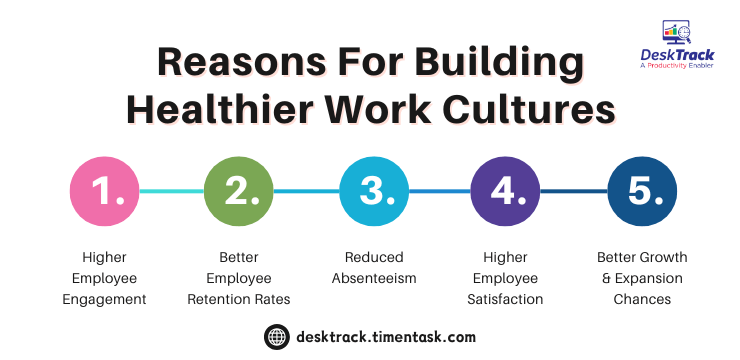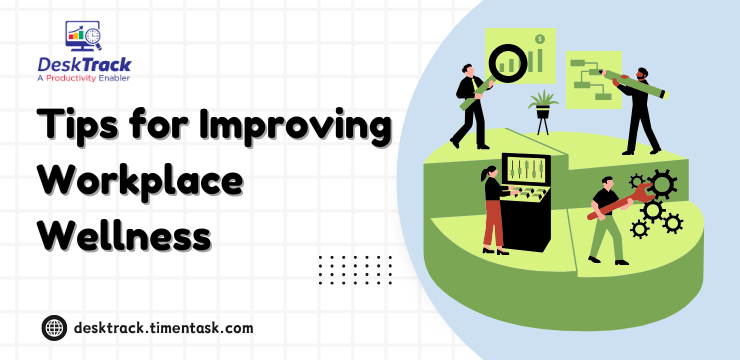
Building healthier work cultures is a compulsion for organizations these days rather than just an option. Businesses must ensure fairness, not exceed maximum mandatory work hours, and inclusiveness towards all employees. There is no room for micromanagement and employees from diverse backgrounds must be treated equally for maximum success and growth.
Wait, that summarized our title. So what are we here for? Did you know that workplace stress is one of the biggest causes of heart disease, mental health issues, and even suicide? 13.5% as per various experts to be exact. That’s huge. So we will provide you with proven strategies to make an inclusive workplace culture.
By the end of this post, you will know the importance of building healthier work cultures. Plus, we will provide you with a plethora of strategies for the same. Finally, we will reveal the software we use to assist in improving our workplace environment. With that out of our way, let’s get right into it.
5 Reasons For Building Healthier Work Cultures

There are many reasons to build and most importantly maintain a healthy culture in the workplace. Not only does it improve employee efficiency but also ensures smoother workflows. With that being said, here are 5 strong reasons you should start working on improving your workplace environment if you haven’t already.
1. Higher Employee Engagement
Building healthier work cultures results in higher employee engagement. When every employee is treated equally, they work with more dedication and enthusiasm towards your goals. What this does is improve efficiency and workflow resulting in better-quality work, resulting in:
- Higher client satisfaction
- More clients and projects for your business
- Increased profitability
- More success and growth
What else do you need? Reduced or eliminated insider threats? Utilizing employee monitoring software can help you achieve this faster than you would expect.
2. Better Employee Retention Rates
Improving workplace wellness results in higher employee retention rates. You retain more employees due to an improved work satisfaction quota. Plus, don’t forget that you are getting more engaged and dedicated employees working for you.
3. Reduced Absenteeism
Building healthier work cultures also results in reduced absenteeism. As all employees are treated equally and there is almost zero workplace stress, employees will start frequenting workplace visits. Overall, this will also save expenses and increase staff availability in your organization.
4. Higher Employee Satisfaction
Inclusive workplace cultures are those where every employee regardless of their post is treated equally. This of course increases employee satisfaction rates as there are no cultural biases. Practical examples of this are organizations where every employee receives the same holiday gift and even CEOs have to stand in line to receive them.
5. Better Growth & Expansion Chances
Building healthier workplace cultures increases your opportunities for growth and global expansion. This is due to:
- You retaining more employees,
- Having a better reputation as an organization that treats its employees like human beings.
- You receiving more clients, higher customer satisfaction, more projects, and maximum profitability.
Read Also: 7 Workplace Challenges for 2025 & How to Overcome Them
5 Strategies for Building Healthier Work Cultures in 2025

Now we know that maintaining a healthy culture in the workplace provides you with many benefits. However, to achieve them, you will typically brainstorm a lot, which will be time-consuming and may lead you nowhere. Instead, the better alternative is to implement these 5 simple and effective strategies we are providing you with.
1. Celebrate Milestones for Positivity
One of our tried and tested ways of building healthier work cultures in 2025 and beyond is to celebrate milestones. Doing so will create a positive work environment throughout your organization, which will keep employees engaged to keep working harder and smarter to achieve your objectives. Plus, it also improves employee retention and satisfaction rates. Trust us, this one is 100% practical and effective.
2. Flexible Work Scheduling
A simple method to achieve a positive workplace environment is to implement a flexible work schedule in your organization. What you can do is instead of including a fixed clocking time, you can make flexible slots such as 9:00/9:30 to 6:30/7:00. Another thing you can do is create flexible work schedules that align with the personal needs of your employees. The idea here is that you need to ensure that the employees work the required hours for you. However, you can delegate how they manage it.
3. Set Boundaries
Another thing to remember is that your employees are not robots. They too have life outside your office hours. So you need to understand these limits to establish workplace wellness. You need to set clear work hour boundaries and ensure that you don’t call your employees after they punch out and/or those who are on time off. Unless it’s urgent (which is never).
4. Build Trust
A simple yet unnoticed method of building healthier work cultures is to have a bond of trust between organizations and employees. However, rarely any business implements this and thus lose more employees than they hire. On the other hand, for businesses like yours that believe in building employee trust, here are a few tips.
- Set work and policy transparency, which ensures no confusion during work.
- Allow your employees access to all the resources they need to get the work done.
5. Prioritize Wellness
Prioritizing the physical and mental employee wellness will go a long way towards improving engagement and employee dedication, leading to more efficiency, productivity, profitability, success, and growth for your organization. What you can do to achieve this is improve the work-life balance of your employees. One of the best ways for you is to implement flexible working schedules to lead to better employee wellness.
12 Tips for Improving Workplace Wellness in 2025

As a follow-up to our fifth tip for building healthier workplace cultures, we will give away 12 of the best tips to improve employee well-being for a more productive employee pool. We are including tried and tested methods for this task. These strategies worked for us, so we are sure that they will give you the expected outcome as well.
1. For Employers:
From the employer side, there are 7 strategies for you to improve employee wellness. Below, we have mentioned some of the simple yet effective tips, which you must utilize to ensure that your employees are physically as well as mentally present in your organization.
1.1 Include Corporate Wellness Programs
The first step for building healthier work cultures with higher employee well-being is to include corporate wellness programs. The idea is for you to help your employees adopt healthier habits. You can get these scheduled weekly or monthly as per your capacity. You can include various stress management workshops and fitness challenges that focus on various aspects including:
- Smoking cessation
- Weight management
- Mental health awareness (personalized solutions for each employee)
Read Also: The Future of Work: Integrated Tools for Productivity in 2025
1.2 Provide Healthcare Benefits
A simple and effective way for you to improve employee wellness is to provide them with healthcare benefits. Yes, that’s right. These include health insurance, life insurance, accidental benefits, and complimentary health checkups. This sends a message that you care about your employees’ well-being and inspires them to work harder, smarter, and better for you.
1.3 Use Telemedicine Solutions
If you can’t physically provide wellness solutions for building healthier work cultures, then your alternative is to use telemedicine solutions. In short, it is called remote healthcare, which ensures that your employees can:
- Address mental and physical health issues promptly
- Your remote employees also feel equally supported
- Receive private and convenient health consultations
1.4 Implement Biometric Screenings
Sometimes, diseases and/or mental and physical injuries go unnoticed. For such cases, a practical and easily accessible approach is to use biometric screenings for employee wellness. Doing so will help you identify underlying health issues, which you may have previously missed.
1.5 Focus on Work-Life Balance
As we mentioned before, providing work-life balance is one of the most essential elements of building healthier work cultures. Here are a few strategies you can implement to achieve this goal.
- Allow flexible work schedules. Especially for single working mothers and those female employees who have the strength and need to work during the early stages of maternity.
- Provide enough breaks and time off to employees for them to be able to enjoy quality time with family and friends, attend to their personal duties, and/or cure their sickness.
- Allow working students to go home earlier than your clock out time so that they can easily manage their studies.
- Provide priorities and specific benefits to specially-abled employees to create an all-inclusive work atmosphere.
1.6 Support Mental Health Initiatives
A big part of supporting employee wellness in your organization is to focus on improving their mental health to the point of maximum. What you need to do is reduce stigma and provide actual support by:
- Providing employee assistance programs (EAPs)
- Providing access to therapy and/or counselling services
- conducting regular stress management and mindfulness workshops
1.7 Promote Healthy Workplace Habits
A great way to build a healthier work culture in your organization is to inspire your employees to practice healthy workplace habits including:
- Taking regular breaks to rejuvenate the mind and work with more enthusiasm
- Staying hydrated and maintaining a balanced diet
- Participating in physical activities such as walking
- Providing your employees with healthy snacking options and/or organizing wellness challenges.
2. For Employees:
Employees also have to play a great part in improving employee wellness. If you are also a working professional of entry-level, you can follow these tried and tested tips to boost your morale and eliminate any kind of work stress.
2.1 Organize Your Workspace
Building healthier work cultures from the employees’ end involves organizing your workspace. We suggest keeping your desks clean and rid of any unnecessary files and folders. Plus, you can also declutter your digital systems. All this results in you working with a cool and calm mind, which boosts productivity.
2.2 Take Movement Breaks
Sitting and working all day will take a toll on your back (spine) and mind. You will physically and mentally get tired, which will lead to burnout. However, if you take regular movement breaks during work for employee wellness, it will relax and reset you to work better. Just don’t wander off for too long, unless you want to be scolded by your manager or worse, end up looking for a new job.
2.3 Mandatory Mindfulness Matters
Building healthier work cultures also includes mindfulness and yoga. Let us tell you that these are like magic healers to your physical and mental health issues. Furthermore, practicing yoga and mindfulness daily can help you cope with any level of work pressure with a calm mind.
Read Also: Why Your Business Needs Time Tracking Software For Healthcare, Accounting, and Beyond
2.4 Bring Healthy Meals
Let’s skip the old lore that a healthy mind lives in a healthy body and get to our main point. The best way to improve employee wellness on your own accord is to bring a healthy lunch from home. If this is not possible, order from a tiffin center instead of a fast food place. Overall, the healthier you eat, the fewer sick leaves you will take, which benefits your organization and in turn, you.
2.5 Improve Workplace Environment
We are not suggesting you add fancy lights and themes to your workplace. However, a little positivity won’t do you any harm. For example, adding plants and lucky charms strategically will always start, middle, and end your day on a positive note and in our opinion, this is the best way to build healthier work cultures.
Building Healthier Work Cultures in 2025 with DeskTrack
Using DeskTrack can provide you with great assistance in gradually instilling a healthy culture in the workplace.
This time tracking, employee monitoring, project management, and productivity monitoring software integration can help you with the same by:
- Monitoring employee activities in real-time. This feature will help you identify unusual work patterns and give you an indication that it’s time to modify your workplace environment.
- The real-time work-hour tracking and work-time utilization reporting feature can help you and your employees effectively manage their time.
- The software facilitates break-taking as you and your employees can pause and resume tracking at any time.
Conclusion
We now hope you have wrapped your head around building healthier work cultures. These days, maintaining an all-inclusive and healthy work environment in your organization is necessary for improving employee efficiency, maintaining productivity, and maximizing employee engagement. Overall, maintaining a healthy work atmosphere is more of a compulsion in 2025 and beyond and not an option, which most organizations think it is. In all usual case scenarios, you will brainstorm, calculate expenses, and do other tasks to get to a solution. Doing so will get you nowhere. Instead, a better alternative for you is to use simple and effective, tried and tested methods with DeskTrack for assistance to gradually get to the point of being the best workplace.
Frequently Asked Questions (FAQ)
Q.1 What are the Reasons for Building Healthier Work Cultures?
Ans. Here are a few reasons for building healthier work cultures.
- Higher Employee Engagement
- Better Employee Retention Rates
- Reduced Absenteeism
- Higher Employee Satisfaction
- Better Growth & Expansion Chances
Q.2 What are Some Strategies for Building Healthier Work Cultures?
Ans. These are 5 of the best strategies for building healthier work cultures.
- Celebrate Milestones for Positivity
- Flexible Work Scheduling
- Set Boundaries
- Build Trust
- Prioritize Wellness
Q.3 What Can Employers Do to Improve Employee Wellness?
Ans. As an employer, you can implement these strategies to improve workplace wellness.
- Include Corporate Wellness Programs
- Provide Healthcare Benefits
- Use Telemedicine Solutions
- Implement Biometric Screenings
- Focus on Work-Life Balance
- Support Mental Health Initiatives
- Promote Healthy Workplace Habits
Q.4 What Can Employees Do to Improve Workplace Wellness?
Ans. As an employee, you can improve your workplace wellness and the well-being of your colleagues for building healthier work cultures by:
- Organizing Your Workspace
- Taking & Encouraging Movement Breaks
- Compulsating Mindfulness & Yoga
- Bringing and Sharing Healthy Meals
- Improving Workplace Environment











